
The Northrop GrummanEA-6B Prowler is a twin-engine, four-seat, mid-wing electronic-warfare aircraft derived from the A-6 Intruder airframe. The EA-6A was the initial electronic warfare version of the A-6 used by the United States Marine Corps and United States Navy. Development on the more advanced EA-6B began in 1966. An EA-6B aircrew consisted of one pilot and three Electronic Countermeasures Officers, though it was not uncommon for only two ECMOs to be used on missions. It was capable of carrying and firing anti-radiation missiles (ARMs), such as the AGM-88 HARM.
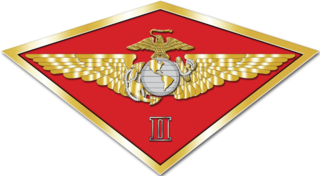
The 2nd Marine Aircraft Wing is the major east coast aviation unit of the United States Marine Corps and is headquartered in Marine Corps Air Station Cherry Point, North Carolina. The Wing provides the aviation combat element for the II Marine Expeditionary Force.

Marine Tactical Electronic Warfare Training Squadron 1 (VMAQT-1) was a United States Marine Corps electronic warfare training squadron consisting of EA-6B Prowler jets. The squadron was based at Marine Corps Air Station Cherry Point, North Carolina and fell under the command of Marine Aircraft Group 14 (MAG-14) and the 2nd Marine Aircraft Wing. The VMAQT-1 logo was the Banshee, an Irish mythological figure foretelling death. Its motto was “Tairngreacht Bas,” Gaelic for “Death Foretold.”
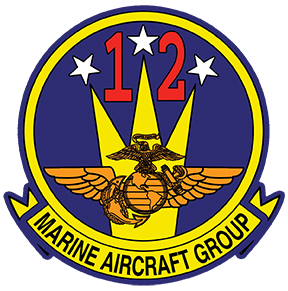
Marine Aircraft Group 12 (MAG-12) is an active air group of the United States Marine Corps, tasked with providing fighter and assault support aircraft. It is currently part of the 1st Marine Aircraft Wing, itself an integral part of the III Marine Expeditionary Force, and based at MCAS Iwakuni in Japan.

Marine Aircraft Group 11 is a United States Marine Corps aviation unit based at Marine Corps Air Station Miramar that is currently composed of two F-35C squadrons, one F-35B squadron, two F/A-18C squadrons, one fleet replacement squadron, one KC-130J tactical aerial refueling squadron, a maintenance and logistics squadron, and a wing support squadron. They fall under the command of the 3rd Marine Aircraft Wing and the I Marine Expeditionary Force.

Marine Tactical Electronic Warfare Squadron 2 (VMAQ-2) was a United States Marine Corps electronic warfare squadron in service from 1952 to 2019. It was the last squadron flying the Northrop Grumman EA-6B Prowler.
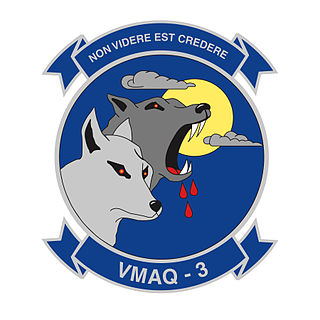
Marine Tactical Electronic Warfare Squadron 3 (VMAQ-3) was one of four Tactical Electronic Warfare Squadrons in the United States Marine Corps. The squadron consisted EA-6B Prowler jets and was tasked with conducting airborne electronic warfare. The squadron was based at Marine Corps Air Station Cherry Point, North Carolina and fell under the command of Marine Aircraft Group 14 (MAG-14) and the 2nd Marine Aircraft Wing. The squadron was decommissioned on May 11, 2018 as the Marine Corps sunsets the EA-6B Prowler.
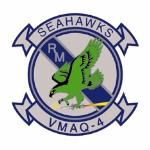
Marine Tactical Electronic Warfare Squadron 4 (VMAQ-4) was a United States Marine Corps electronic warfare squadron consisting of EA-6B Prowler jets. The squadron was last based at Marine Corps Air Station Cherry Point, North Carolina and fell under the command of Marine Aircraft Group 14 (MAG-14) and the 2nd Marine Aircraft Wing. The squadron was decommissioned on June 2, 2017 as the Marine Corps sundowns the EA-6B Prowler.

Marine Aircraft Group 13 is a United States Marine Corps aviation unit based at Marine Corps Air Station Yuma that is currently composed of one McDonnell Douglas AV-8B Harrier II squadron, three Lockheed Martin F-35B Lightning II squadrons, an unmanned aerial vehicle squadron, a maintenance and logistics squadron, and a wing support squadron. The group falls under the command of the 3rd Marine Aircraft Wing and the I Marine Expeditionary Force.

Marine Aircraft Group 26 (MAG-26) is a United States Marine Corps aviation unit based at Marine Corps Air Station New River composed of seven MV-22 Osprey squadrons, one of which is the Fleet Replacement Squadron, an aviation logistics squadron, and a wing support squadron. It falls under the command of the 2nd Marine Aircraft Wing and II Marine Expeditionary Force.

Marine Aviation Logistics Squadron 16 (MALS-16) is an aviation logistics support unit of the United States Marine Corps. Known as the Immortals, they are currently based at Marine Corps Air Station Miramar and fall under the command of Marine Aircraft Group 16 (MAG-16) and the 3rd Marine Aircraft Wing.
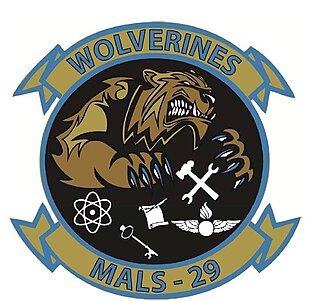
Marine Aviation Logistics Squadron 29 (MALS-29) is an aviation logistics support unit of the United States Marine Corps. Known as the "Wolverines", they fall under the command of Marine Aircraft Group 29 and the 2nd Marine Aircraft Wing and are currently based at Marine Corps Air Station New River. MALS 29 supports multiple types of aircraft and provides detachments to aviation combat elements operating globally in support the United States National Defense Strategy.

Marine Aviation Logistics Squadron 12 (MALS-12) is an aviation logistics support unit of the United States Marine Corps. Known as the "Marauders", they fall under the command of Marine Aircraft Group 12 (MAG-12) and the 1st Marine Aircraft Wing and are currently based at Marine Corps Air Station Iwakuni.

Marine Aviation Logistics Squadron 39 (MALS-39) is an aviation logistics support unit of the United States Marine Corps. Known as the "Hellhounds", they fall under the command of Marine Aircraft Group 39 (MAG-39) and the 3rd Marine Aircraft Wing and are currently based at Marine Corps Air Station Camp Pendleton, California..

Marine Wing Communications Squadron 28 (MWCS-28) is a United States Marine Corps communications squadron. The squadron provides expeditionary communications for the aviation combat element of the II Marine Expeditionary Force. They are based at Marine Corps Air Station Cherry Point and fall under the command of Marine Air Control Group 28 and the 2nd Marine Aircraft Wing.
A Marine expeditionary brigade (MEB) is a formation of the United States Marine Corps, a Marine air-ground task force of approximately 14,500 Marines and sailors constructed around a reinforced infantry regiment, a composite Marine aircraft group, a combat logistics regiment and a MEB command group. The MEB, commanded by a general officer, is task-organized to meet the requirements of a specific situation. It can function as part of a joint task force, as the lead echelon of the Marine expeditionary force (MEF), or alone. It varies in size and composition, and is larger than a Marine expeditionary unit (MEU) but smaller than a MEF. The MEB is capable of conducting missions across the full range of military operations.
In the United States Army, the term combat support refers to units that provide fire support and operational assistance to combat elements. Combat support units provide specialized support functions to combat units in the following areas

United States Marine Corps Aviation is the aircraft arm of the United States Marine Corps. Marine Corps aviation units have a very different mission and operation than their ground counterparts and thus have their own history, traditions, terms, and procedures. Aviation units within the Marine Corps are assigned to support the Marine Air-Ground Task Force, as the aviation combat element, by providing six functions: assault support, antiair warfare, close air support, electronic warfare, control of aircraft and missiles, and aerial reconnaissance. The Corps operates rotary-wing, tiltrotor, and fixed-wing aircraft mainly to provide transport and close air support to its ground forces. Other aircraft types are also used in a variety of support and special-purpose roles. All Marine Corps aviation falls under the influence of the Deputy Commandant for Aviation, whose job is to advise the Commandant of the Marine Corps in all matters relating to aviation, especially acquisition of new assets, conversions of current aircraft, maintenance, operation, and command.

Electronic Attack Squadron 141 (VAQ-141), also known as the "Shadowhawks", is an EA-18G Growler squadron of the United States Navy that is based at Marine Corps Air Station Iwakuni, located in Iwakuni, Yamaguchi, Japan. VAQ-141 falls under the cognizance of Commander, Electronic Attack Wing Pacific (COMVAQWINGPAC) and flies in support of Carrier Air Wing 5 (CVW-5) aboard the Nimitz-class aircraft carrier, USS Ronald Reagan (CVN-76).
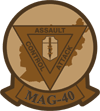
Marine Aircraft Group 40 is a composite United States Marine Corps aviation unit that is based in Marine Corps Air Station Cherry Point and was deployed to Afghanistan in 2009. They served as the aviation combat element for 2nd Marine Expeditionary Brigade which was supporting Operation Enduring Freedom from spring 2009 through April 4, 2010 when they were relieved by the 3rd Marine Aircraft Wing (Fwd). The group is currently composed of two CH-53 squadrons, one light attack helicopter squadron, one AV-8B Harrier II squadron, one MV-22 Osprey squadron, one KC-130 tactical aerial refueling squadron, one unmanned aerial vehicle squadron and an aviation logistics squadron.




















